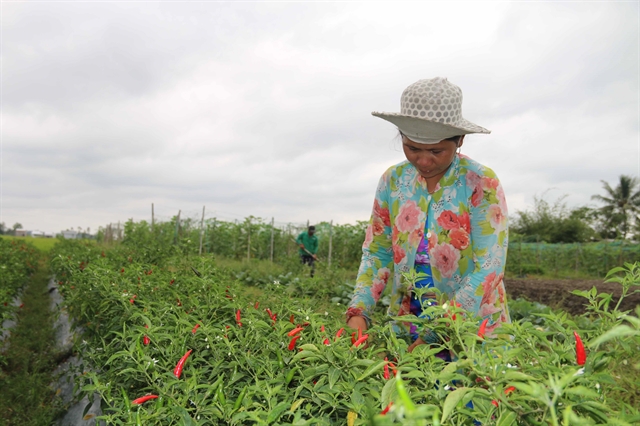 Society
Society


|
| Farmers in Châu Thành District, Trà Vinh Province have switched from planting rice to growing chili peppers, increasing their profits fourfold. VNA/VNS Photo Thanh Hòa |
TRÀ VINH — Many farmers in the Mekong Delta province of Trà Vinh have escaped poverty by adapting to climate change and shifting from rice to corn or peanut cultivation as well as the breeding of goats and aquatic species.
Farmers in the last five years have converted about 18,000ha of ineffective rice fields in the province to other crops, and have also been breeding aquatic species and animals.
The converted areas offer 1.5-3 times more profit than rice, according to the province’s Department of Agriculture and Rural Development.
Since 2017, 10 farmers in a cooperative team, for example, have been breeding blood cockles on a 0.6ha alluvial ground in Duyên Hải District’s Long Khánh Commune.
The team invested VNĐ170 million (US$7,300), including VNĐ120 million from the Project for Adaptation to Climate Change in Trà Vinh to buy blood cockle seeds, nets and stakes.
Blood cockles breed for eight months and the harvest season lasts about two months.
Each team member makes a profit of VNĐ8 million ($343) from selling the cockles in each harvest. Members are also paid VNĐ100,000-150,000 ($4-6) each a day for preparing the breeding area, harvesting blood cockles or grading blood cockles.
Nguyễn Thị Nguyệt Nga, head of the team, said that five of the 10 members once belonged to poor and near-poor households but were able to escape poverty after harvesting two crops.
The breeding of blood cockles requires little up-front investment as only seeds, nets and stakes are needed.
Importantly, blood cockles can live in water with a salinity content of up to 3.5 per cent and feed on natural food in water.
Located between the Cổ Chiên and Hậu rivers with a 65 km coastline, Trà Vinh is often affected by saltwater intrusion, rising sea levels and erosion.
The province has more than 186,000ha of farmland, accounting for 79 per cent of its total land area.
More than 90 per cent of the province’s land is affected by saltwater intrusion between December and June in the dry season.
Phạm Minh Truyền, director of the province’s Department of Agriculture and Rural Development, said that farmers were adapting to climate change by shifting from rice to other crops and breeding animals or aquatic species.
The province has encouraged them to sign contracts with companies to guarantee outlets for their products, establish large-scale rice fields, and apply good agricultural practices (GAP) standards in agriculture, aquaculture and forestry production.
The province’s Co-operative Alliance has also urged members to build brand names for their products, and has provided them with management training.
The province has 119 agricultural co-operatives, accounting for 67 per cent of its total cooperatives.
To mitigate the impact of climate change, the province has built embankments and sluice gates, and has dredged irrigation canals to store freshwater.
Crab farming
The breeding of mud crabs has also brought higher incomes under extensive farming in mangrove forests.
The An Khang Mud Crab Breeding Co-operative Team in Duyên Hải District began in 2017 with 10 members who were given financial support to buy mud crab seeds, food and other inputs.
The team’s 10 members breed mud crabs in a 4.6ha mangrove forest, earning a profit of VNĐ20 – 30 million ($858 – 1,287) a crop each.
Cô Văn Tâm, head of the An Khang Mud Crab Breeding Co-operative Team in Duyên Hải District’s Long Vĩnh Commune, said the breeding model was simple for poor households to carry out as it needed less tending and the crabs mostly eat industrial food, small fish and mussels.
Nguyễn Văn Phùng, deputy director of the province’s Agriculture Extension Centre, said: “The model is sustainable and suitable for developing in climate-change affected areas.”
The model would be expanded in Duyên Hải’s Đôn Xuân, Đôn Châu and Ngũ Lạc communes, he said.
The province is one of the delta’s largest mud crab producers. It has more than 9,000ha of mangrove forests and protective forests along the coast.
It has allocated nearly 5,460ha of forests to poor and near-poor households to tend and harvest. In the forests, the households breed aquatic species to earn additional income. — VNS




